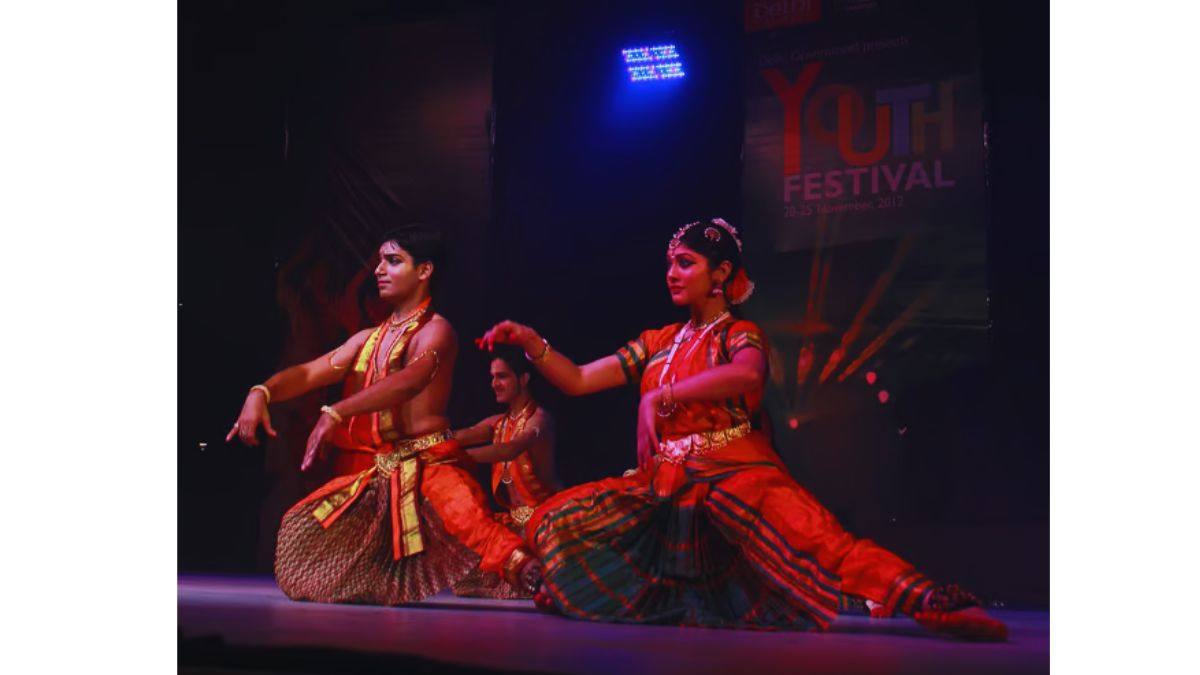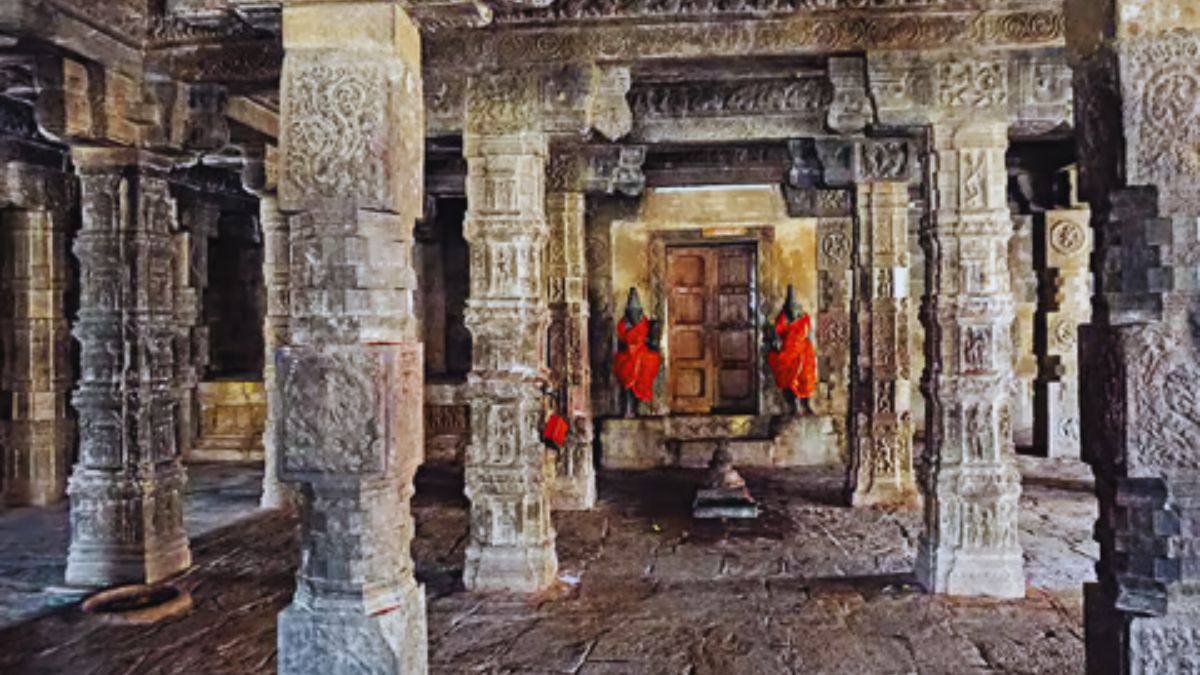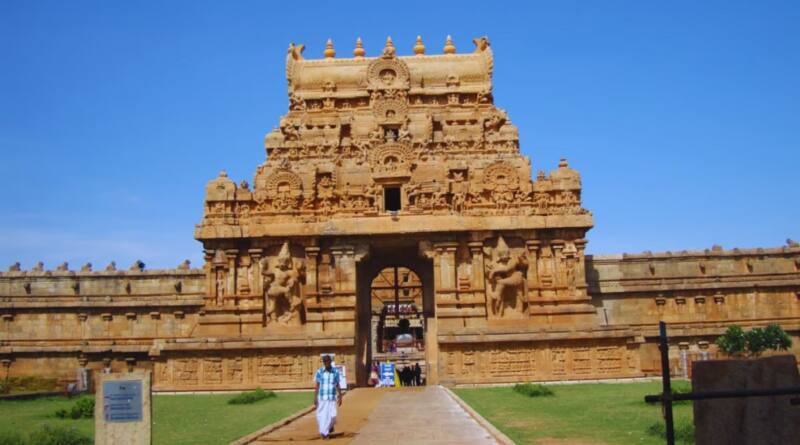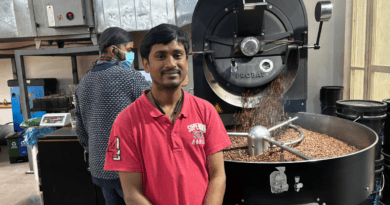Look, this ultimate guide to Thanjavur is perfect.
To be honest, it takes guts to say ‘yes’ to an invitation to attend a festival of sacred south Indian music when you only have a passing familiarity with the genre—but here I was, winging it to Chennai and then to Thanjavur to rub shoulders with aficionados of one of India’s most lasting cultural legacies. Tamil Nadu not only gave us modern Bharatanatyam but also an incredibly rich tradition of Carnatic music. Thank heavens! I have an ear for music.

The country road from Tiruchi airport leads to modern-day Thanjavur, which is about an hour away. Ugly residential blocks and a chaotic jumble of ramshackle shops have encroached on the sacred spaces of Thanjavur’s Big Temple, the mighty landmark of this Chola bastion. Yet there it is—an oasis of tranquilly that has been lovingly nurtured for over a thousand years since its Chola heyday.
The unappealing tenements nearby may deter you, but the bazaars are vibrant and colourful, with jasmine veni and garland stalls doing brisk business. A walk through the Old Quarter with an Intach guide puts everything into perspective. The grid structure of the royal enclave, with its centre of fine arts, leads us to Ponnayya Nilayam, the humble home of the Tanjore Quartet. The four brothers, Chinnayya, Ponnayya, Vadivelu, and Sivanandam, were music and dance geniuses who established the foundation for Bharatanatyam as it exists today.
As we enter the house’s pillared hallway, we notice a group of children practicing the baby steps of this graceful dance form. A family member reverently displays the violin on which Vadivelu Pillai first learned to play. Rukmini Devi, Vyjayanthimala, Alarmel Valli, and many others came here to learn their trade. Someone needs to work hard to give this location its due respect as a historic cultural heritage site.
Ranvir Shah, a Chennai-based businessman turned culture czar who is deeply committed to reviving Thanjavur’s cultural heritage, believes the work has only just begun with his Prakriti Foundation’s annual Festival of Sacred Music in Thiruvaiyaru, on the outskirts of Thanjavur.
Thiruvaiyaru, located on the Cauvery River, was a traditional centre for classical music in the southern region. Unfortunately, the sacred Cauvery River has almost vanished in Tamil Nadu. We are fortunate that we can still stand knee-deep in Thiruvaiyaru’s waters. Later, on the road to Thiruvarur, I’m appalled by the massive, dry riverbed that serves as our companion for part of the way. It’s unlawful.
Thiruvaiyaru’s importance has dwindled, much like the Cauvery. The legendary poet-saint Thyagaraja wrote many of his 7,000 compositions on the banks of this inspiring river. With sand in our sandals, we arrive at his samadhi, close to where he lived in a one-room tenement near his favourite river.
The pilgrim town, with its ancient temple to Panchanadheeswarar (Shiva as the lord of five rivers that flow past here, one of which is the Cauvery), or Aiyyaarappar, resounds with Holi revelry on the first night of the festival.
At the Amman temple festival near the Cauvery Bridge, we watch in awe as devotees perform the fire-walking ritual before heading to the adjoining Diwan Wada for a concert.
Meanwhile, diyas flicker in the old pura koondu (dovecote), and Orion stands directly overhead in the night sky, while a full moon showers silver light on us mortals, enraptured by the music of Krishna’s Temple Rock and the Filter Coffee Fusion Band, who perform from a raised platform beneath a spreading tree ablaze with green lights. The Holi revellers’ fireworks and patakas occasionally add their own interpretations to this rich repast.
The following morning, on our way to Mangala, a heritage homestay in Thirupugalur where lunch awaits, we stop by the massive Thyagarajaswamy temple complex in Thiruvarur.
The lively V.R. Devika, scholar extraordinaire of Tamil culture, who is showing us around, recalls a visit here when her friends and she were surrounded by streams of terrified villagers seeking refuge, and the boom of the tsunami at Nagapattinam shook the earth of Thiravarur from 20 kilometres away.
The 6th-century Sri Agneeswarar Shiva temple, with its sacred tank, kisses the blue skies above the 800-person village of Thirupugalur. The verandah at the Mangala Heritage Home has custard-yellow walls that contrast well with the surrounding foliage and the green gleam of the tank across the road.
Slipping off our shoes, we enter the cool interiors of the inner courtyard and sink against the cushions to eat a traditional Tamil lunch served on banana leaves on the wraparound verandah. A discrete, satisfied burp acknowledges the simple but delicious meal prepared in the kitchen by a smiling Mani, the local village woman who arrives to cook.
The evening finds us gathered once more on the banks of the Cauvery in Thiruvaiyaru. The setting sun shines kindly on its severely depleted flow. Hundreds of students from schools and colleges, local officials, and temple administrators have been enlisted to clean up the riverside near the Kalyan Mahal Ghat. There are plans to make this a continuous process.

While we watch the floodlights reflect off the Cauvery’s waters, 45 Manganiyar musicians tune up their instruments on the opposite bank from where we are seated, transporting us from the Cauvery’s sands to the desert sands of Rajasthan. Our final evening is spent in one of the Panchanadeeswarar temple’s many mandapams, where Guru Kadri Gopalnath performs Carnatic music on a saxophone to a rapt audience.
The next morning, I’m back in Mangala for a more leisurely stay. It’s a rural haven for writers and artists, but it’s also ideal for a group of family and friends looking for a taste of the Tamil countryside. Ranvir transformed this traditional Tamil village home, which he discovered by chance.
There are five air-conditioned guestrooms that are spacious and simply furnished, with modern bathrooms featuring hand-beaten brass washbasins made in Pune. Natural light makes its way through the house. Near dinnertime, I slip into the kitchen and teach Mani how to make homemade paneer cooked in the Punjabi style. Later, she smiles and sends me off to bed with a thimble of filter kapi.
Early the next morning, I greet the ancient woman who has come from the village to draw the kolams around the house. Except for birdsong and the clatter of breakfast dishes, all is quiet. Mangala does not feel like a tourist trap guesthouse. Rather, it blends in perfectly with its natural surroundings.
The atmosphere is one of rural Tamil comforts, vegetarian home cooking, and the sounds of silence. Tranquebar, a beautiful seaside retreat, is only 40 minutes away. The museum in the Dutch fort here transports me to a world of sailboats and local rajas. Before dawn, we can travel to Nagore, 10 kilometres away, to watch fishermen haul in the night’s catch. It’s just another day in this beautiful part of the world.
What to See and Do?
The Thanjavur delta is home to one of the world’s finest temple collections, including three Unesco World Heritage Sites (the Big Temple, Gangaikondacholapuram, and Darasuram). Thanjavur is a good starting point for exploring the region; nearly all villages and towns in the delta are accessible in less than two hours on good roads with frequent bus service.





One more important issue is that if you are a mature person, travel insurance with regard to pensioners is something you must really think about. The older you are, a lot more at risk you will be for allowing something negative happen to you while abroad. If you are not really covered by many comprehensive insurance policy, you could have several serious troubles. Thanks for expressing your advice on this blog site.
Hello There. I discovered your weblog the use of msn. That is an extremely neatly written article. I will be sure to bookmark it and return to learn more of your helpful information. Thanks for the post. I’ll certainly comeback.